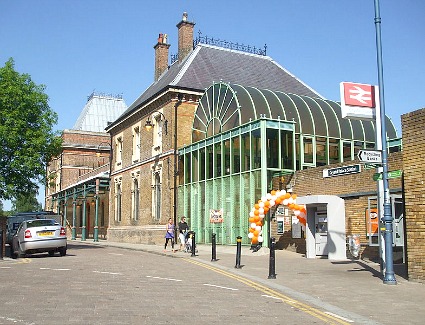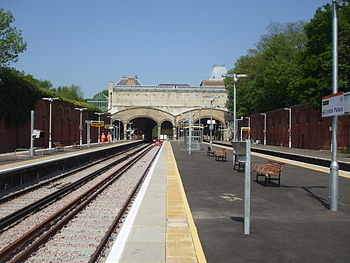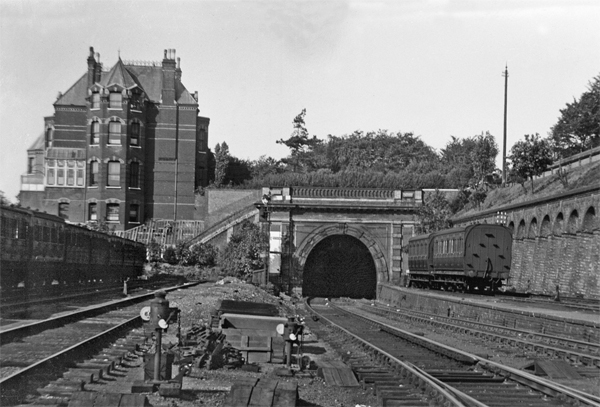Crystal Palace railway station
- Outer South London Line
- London Bridge Beckenham Junction
- London Victoria - Crystal Palace - Sutton
- East London Line
I7i11i12i13i15i16i16i18i20
The Crystal Palace railway station is a railway station and regional rail transport hub in the London Borough of Bromley, and is located between the two districts Crystal Palace and Penge, named after the between 1851 and 1936 fire nearby Crystal Palace. The station is located in the property of Network Rail will, but operated by Southern. In addition to Southern trains also serves the London Overground train station. It is located on the boundary of Travelcard Zone 3 and 4 In 2011 there were 1.869 million passengers the station.
- 3.1 Tramlink connection
- 3.2 Construction of the railway station
History
The station was built in 1854 by the West End of London and Crystal Palace Railway ( WEL & CPR) to open up the Crystal Palace after it was moved in 1851 from Hyde Park to Sydenham Hill. The station should serve primarily to accommodate the flows of spectators to and from the palace. The trains were operated by the London, Brighton and South Coast Railway. Initially he was endpoint of a branch line from Sydenham, but was expanded in 1856 to the transit station, as the existing route via West Norwood to Clapham Junction Railway was extended. For the construction of the 690 meter-long tunnel as Crystal Palace passing under the palace was necessary, the outbreak was shown in spite of its short length as a great achievement of his time, as the auszubrechende material, clay minerals, and the palace itself for the workers represented difficult obstacles.
1857 connect buckle for Norwood Junction railway station was built on the Brighton Main Line, which was extended a year later for an extension to, situated on the North Kent Line Station Beckenham Junction. They separate at the level of grade- crossing the BML. The latter route is now shared in its eastern section of the Croydon Tramlink. By extending Crystal Palace became the separation station. The separation of routes from West Norwood to Sydenham or Norwood Junction is located in front of the train station, so that it has the track plan a wedge station with platforms on both branches. Unlike most wedge stations, however, the reception building is not located between the tracks. Today's tracks 1 and 2 are on the road to Sydenham, the tracks 3-7 are used to transport to Norwood Junction / Beckenham Junction.
1860 Direct trains were offered to Victoria Station for the first time. 1875 Victorian station building was first converted. In 1898, he was renamed Crystal Palace ( Low Level) to confusion with the already opened 1865 and now-defunct eponymous terminus of a branch line ending at the Catford Loop Line, on which also links to Victoria were performed to avoid. This station was renamed Crystal Palace ( High Level). It was located directly above the Crystal Palace Tunnel, a track connection was not created.
In 1911, the route between Balham and Crystal Palace was electrified. Reason was the meeting held in the framework of the coronation of King George V in Crystal Palace Festival of Empire. The aim was to establish a connection with electric trains between Crystal Palace and Victoria, whose travel time was 15 minutes maximum, a project that has never been achieved. The High Level station was also put under tension, the section Victoria - Balham was electrified since 1903, when the South London Line was fitted as one of the first railway lines of the United Kingdom with an overhead line.
On 2 February 1913, the station came to a spectacular Prellbock crossing because the brake of a train failed with four cars. Meanwhile locomotive broke through a wall, where 9 people were injured, including the heater.
After the Crystal Palace was destroyed in 1936 by fire, the number of passengers dropped at the station rapidly and direct lines of BML were then performed via East Croydon and directly to Clapham Junction, so that the platforms lost on the road to Norwood Junction importance. The main entrance of the station was relocated in the 1980s to the south in order to focus on the distance to Sydenham, which is a part of the Outer South London Line. As part of this restructuring of the station also received a new ticket hall. The design of the hall and the entrance are modeled on the semi-circular roof of the nave of the Crystal Palace. 2002 followed by Railtrack further reconstruction measures in the amount of 4 million pounds sterling.
1954, the High Level station was shut down, the Low Level Station was returned to its original and current name. To decommissioning is shrouded in rumors and legends that say that to this day in the tunnels there is a locomotive, or that the decommissioning of the High Level station an accident is based, in which a passenger was swallowed by the earth and the passengers up today were trapped underground.
2010 the station was one of the southern endpoints of the extended East London Line, which has since traveled no more of subway trains, but by Overground trains. It uses one of the two head platforms that were originally built for ending trains and have not been used since the 1970s. As part of the preparatory work for the East London Line, a new central platform between track 5 and track 6 was used instead of existing buildings newly built and canceled the platform on the disused track 4. The Overground trains end either at the top or at the platform track 5 track 3
Operation
The operating mode at the Crystal Palace station is run by Southern and London Overground. In Crystal Palace take four different Zugsrelationen together. Also, several bus lines of Transport for London to operate the station.
Rail traffic
- London Victoria - West Croydon - Crystal Palace ( - Epsom - Epsom Downs - Sutton ) 2 trains per hour
- London Victoria - Crystal Palace - London Bridge OSLL, 2 trains per hour
- London Bridge - Crystal Palace - Beckenham Junction 2 trains per hour, Monday to Friday
In addition, some features of the Brighton Main Line from Brighton or Eastbourne by going to London Bridge at peak times the train station, but without inserting a timetabled maintenance.
- Highbury & Islington - Whitechapel - New Cross Gate - Crystal Palace 4 trains per hour
Bus
The TfL operated the station during the day in the bus with the lines 157, 249, 358, 410 and 432 as well as at night with the night bus N3.
Future
Tramlink connection
The TfL was planning an expansion of the Tramlink network in the form of a fourth line which would branch off from the existing lines at the bus stop Harrington Road and should lead via Anerley and Crystal Palace train station to the bus station at the Crystal Palace Parade. Three different alignments were discussed .. The construction costs were estimated at 170 million pounds. In November 2008 the Mayor of London, Boris Johnson had announced that the project would be tilted and would if at all, resumed at the earliest after implementation of Crossrail in 2018.
New building of the railway station
The extension of the East London Line was the impetus for the project of a railway station building in Crystal Palace. The Overground trains end date to a head platform, but should be better integrated into the station's atmosphere. In addition, all platforms should be provided with disabled access. The project presented the Bromley Council provides for the following building work before:
- Refurbishment of the reception building
- Demolition of the built in the 1980s banking hall
- Termination of the gangway on the tracks 1 and 2
- Reactivation of the old main entrance and the old ticket hall
- Installation of three acts on the platforms for disabled access
- Platform roof over the tracks 3-7
An accurate vision in terms of date of completion, however, does not exist yet.






.jpg/220px-Crystal_Palace_Low_Level_station_(6453226405).jpg)



